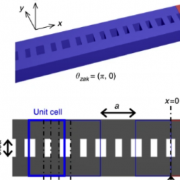Abstract
Topological edge states exist at the interfaces between two topologically distinct materials. The presence and number of such modes are deterministically predicted from the bulk band topologies, known as the bulk-edge correspondence. This principle is highly useful for predictably controlling optical modes in resonators made of photonic crystals (PhCs), leading to the recent demonstrations of microscale topological lasers. Meanwhile, zero-dimensional topological trapped states in the nanoscale remained unexplored, despite its importance for enhancing light–matter interactions and for wide applications including single-mode nanolasers. Here, we report a topological PhC nanocavity with a near-diffraction-limited mode volume and its application to single-mode lasing. The topological origin of the nanocavity, formed at the interface between two topologically distinct PhCs, guarantees the existence of only one mode within its photonic bandgap. The observed lasing accompanies a high spontaneous emission coupling factor stemming from the nanoscale confinement. These results encompass a way to greatly downscale topological photonics.
この情報へのアクセスはメンバーに限定されています。ログインしてください。メンバー登録は下記リンクをクリックしてください。

